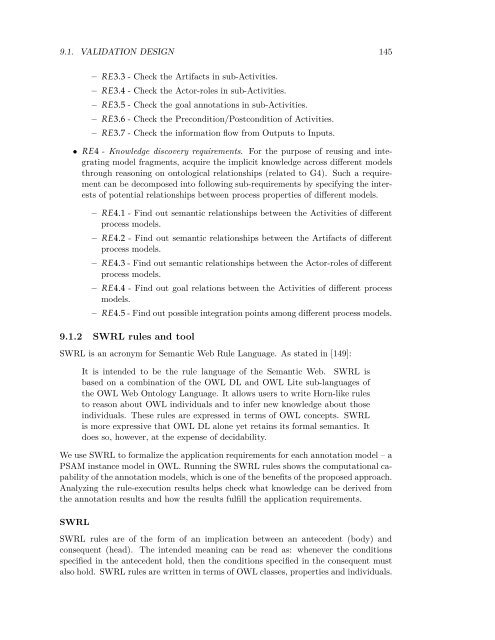Semantic Annotation for Process Models: - Department of Computer ...
Semantic Annotation for Process Models: - Department of Computer ...
Semantic Annotation for Process Models: - Department of Computer ...
You also want an ePaper? Increase the reach of your titles
YUMPU automatically turns print PDFs into web optimized ePapers that Google loves.
9.1. VALIDATION DESIGN 145<br />
– RE3.3 - Check the Artifacts in sub-Activities.<br />
– RE3.4 - Check the Actor-roles in sub-Activities.<br />
– RE3.5 - Check the goal annotations in sub-Activities.<br />
– RE3.6 - Check the Precondition/Postcondition <strong>of</strong> Activities.<br />
– RE3.7 - Check the in<strong>for</strong>mation flow from Outputs to Inputs.<br />
• RE4 - Knowledge discovery requirements. For the purpose <strong>of</strong> reusing and integrating<br />
model fragments, acquire the implicit knowledge across different models<br />
through reasoning on ontological relationships (related to G4). Such a requirement<br />
can be decomposed into following sub-requirements by specifying the interests<br />
<strong>of</strong> potential relationships between process properties <strong>of</strong> different models.<br />
– RE4.1 - Find out semantic relationships between the Activities <strong>of</strong> different<br />
process models.<br />
– RE4.2 - Find out semantic relationships between the Artifacts <strong>of</strong> different<br />
process models.<br />
– RE4.3 - Find out semantic relationships between the Actor-roles <strong>of</strong> different<br />
process models.<br />
– RE4.4 - Find out goal relations between the Activities <strong>of</strong> different process<br />
models.<br />
– RE4.5 - Find out possible integration points among different process models.<br />
9.1.2 SWRL rules and tool<br />
SWRL is an acronym <strong>for</strong> <strong>Semantic</strong> Web Rule Language. As stated in [149]:<br />
It is intended to be the rule language <strong>of</strong> the <strong>Semantic</strong> Web. SWRL is<br />
based on a combination <strong>of</strong> the OWL DL and OWL Lite sub-languages <strong>of</strong><br />
the OWL Web Ontology Language. It allows users to write Horn-like rules<br />
to reason about OWL individuals and to infer new knowledge about those<br />
individuals. These rules are expressed in terms <strong>of</strong> OWL concepts. SWRL<br />
is more expressive that OWL DL alone yet retains its <strong>for</strong>mal semantics. It<br />
does so, however, at the expense <strong>of</strong> decidability.<br />
We use SWRL to <strong>for</strong>malize the application requirements <strong>for</strong> each annotation model – a<br />
PSAM instance model in OWL. Running the SWRL rules shows the computational capability<br />
<strong>of</strong> the annotation models, which is one <strong>of</strong> the benefits <strong>of</strong> the proposed approach.<br />
Analyzing the rule-execution results helps check what knowledge can be derived from<br />
the annotation results and how the results fulfill the application requirements.<br />
SWRL<br />
SWRL rules are <strong>of</strong> the <strong>for</strong>m <strong>of</strong> an implication between an antecedent (body) and<br />
consequent (head). The intended meaning can be read as: whenever the conditions<br />
specified in the antecedent hold, then the conditions specified in the consequent must<br />
also hold. SWRL rules are written in terms <strong>of</strong> OWL classes, properties and individuals.
















